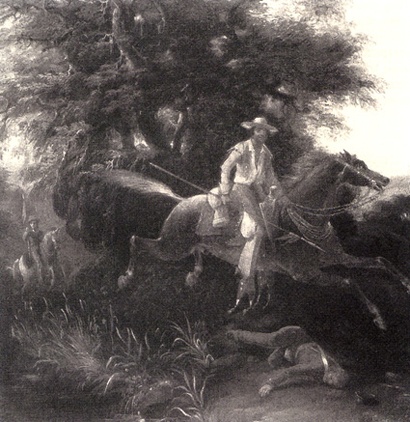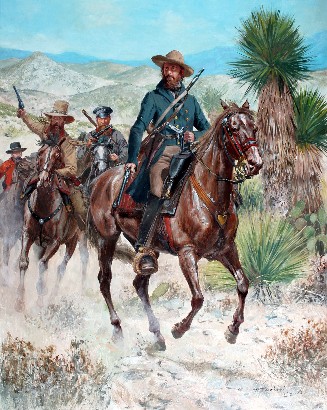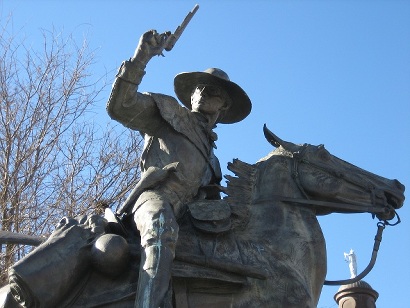|
Books by
Jeffery Robenalt
|
|
| In
March 1847, American President James K. Polk, angered by the unauthorized
armistice agreed to between General Zachary Taylor and Mexican General
Pedro Ampudia at the conclusion of the Battle
of Monterrey, ordered General Winfield Scott to launch
an invasion of Mexico by way of the port of Veracruz. General Scott’s
subsequent amphibious landing and thrust into the interior of Mexico
were designed to bring a quick end to the war by capturing Mexico
City. Although not present for the initial invasion, Jack
Hays and his regiment of Texas Rangers were destined to play an
integral part in bringing the war to a successful conclusion. |
The
amphibious landing at the Battle of Veracruz
painted by N. Currier in the 1840s.
wikimedia commons |
In an effort
to accomplish his difficult mission in a timely manner, General Scott
boldly abandoned the American army’s slow moving logistical tail and
deliberately set out for the capital at a forced march pace that left
his lines of communication and supply stretched and vulnerable. However,
after meeting the forces of Mexican General Santa Anna in a series
of successful, if bloody, engagements, beginning with the Battle
of Cerro Gordo and ending with decisive victories at Molina
del Rey and Chapultepec, Scott proved his strategy sound
by capturing Mexico City on September 14.
Although firmly in possession of the capital, the American army was
now in a precarious position. The Mexican population in the countryside
had been aroused to a fever pitch by the bitter fighting, and to make
matters worse, the long road stretching back to Veracruz ran through
rugged, mountainous terrain, bottlenecked by a succession of deep
gorges, high peaks, narrow passes, and dense forests. Soon local bands of guerrillas gathered and moved into hiding in the
mountains and forests, from where they began to bleed the American
supply line with regularity. |
 |
Mexican
Guerrilla
(Colección Banco Nacional de México)
U.S. Army Center of Military History |
| In early April,
guerrillas successfully ambushed an American supply column, capturing
10 wagons. A few days later, a column of troops marching to reinforce
General Scott lost a quarter of its wagons and many of its men in
a well-coordinated ambush, and another column suffered a hundred dead
out of a thousand on the long march to the capital, without fighting
a pitched battle. The situation was steadily growing worse, and in
the main, efforts to bring the depredations to a halt bordered on
the ludicrous, with each punitive expedition sent out suffering more
casualties than it inflicted and accomplishing little or nothing. |
|
The only unit
with any success against the guerrillas was a company of volunteers
commanded by former Texas
Ranger, Sam Walker, who now held a commission as a captain in
the regular army. The commission was a reward from President Polk
for Walker’s
services to General Zachary Taylor during the battles of Palo Alto
and Reseca de la Palma. From their headquarters in Perote, Walker’s
volunteers roamed far and wide throughout the summer of 1847, harassing
the guerrillas at every opportunity; returning with captured arms,
horses, and wagons, but seldom any prisoners. It was said that Walker’s
volunteers fought the guerrillas in the only way possible, by making
the countryside as dangerous for them as they made it for the Americans.
Unfortunately,
as efficient as Sam
Walker’s volunteers were, a single company of men was insufficient
to stem the guerrilla tide, and the situation worsened when 2000
American soldiers defending Puebla came under a virtual siege
by a guerrilla army personally commanded by General Santa Anna.
Word of the siege spread quickly, and when Santa Anna’s forces grew
to some 5000, General Joseph Lane was ordered to march to
the relief of Puebla. Riding with General Lane’s column was a regiment
of Texas Rangers commanded by Jack
Hays. The Rangers had arrived in Mexico at the express order
of President Polk, who wanted them to “disperse the guerrillas which
infest the line between Veracruz and the interior of Mexico.”
General Zachary Taylor had discharged Hays’
former volunteer regiment at the conclusion of the battle
of Monterrey because he did not want the responsibility of controlling
their raucous behavior during the weeks of relative inactivity that
followed the battle. After their discharge, Colonel
Hays and his Rangers, including Sam
Walker, returned to San
Antonio where they received a hero’s welcome. Jack
Hays and Sam
Walker were not only the most popular men in Texas,
but were also renowned throughout the United States for their exploits
in the war. On November 7, 1846, acting Governor A.C. Horton authorized
Hays
to form a new regiment, and having been appointed a captain in the
U.S. army,
Walker was ordered to report to the adjutant general in Washington.
Since Hays
had business in Mississippi, the two traveled together as far as
New Orleans, where their arrival was celebrated.
Following
his business in Washington, Sam
Walker went on to New York and met with Sam Colt to discuss
the Colt
Paterson revolver. The Paterson had served the Rangers well,
but it was far too light and flimsy to be designed for rugged use
on the frontier. The weapon also had other shortcomings, including
a cumbersome “pop out” trigger with no trigger guard, and the need
to remove the barrel to replace the cylinder, making it impossible
to reload on horseback. Colt agreed to incorporate the changes Walker
suggested in exchange for Sam’s
help in persuading President Polk to purchase the new weapons. Sam’s
efforts were successful, and on January 4, 1847, a contract was
signed whereby the United States agreed to purchase 1000 “Walker”
Colt revolvers.
Meanwhile, a federal requirement that all enlistments must be for
the duration of the war, was making it difficult to fill the roles
of the new Ranger regiment, so Texas
Governor James Pinkney Henderson sent Jack
Hays to Washington to discuss the matter with President Polk
and the secretary of war. The discussions went well, and in response
to Hays’
mission, an order was signed on March 20, 1847, authorizing Ranger
enlistments for one year. While in Washington, Hays
also met with Sam Colt, who wanted him to see the new and improved
six-shot revolver that Sam
Walker had helped to design. Colonel
Hays was impressed, and Colt assured him that his regiment would
be issued the new weapons once Walker’s
company was supplied.
Upon his return to San
Antonio, Colonel
Hays assumed command of the First Regiment, Texas Mounted Volunteers
that was in the process of forming and took time out to be married
in Seguin to
Susan Anderson, the daughter of a Presbyterian pastor. By early
October, all five Ranger companies in the First Regiment were encamped
on the Jalapa Road at Vergara, Mexico, three miles west of Veracruz,
where most of Hays’ 580 Rangers were issued two Walker Colt revolvers.
After two weeks of intense training in marksmanship and maintenance,
the Rangers were highly proficient with the new weapons.
|
|
|
General
Joseph Lane
Wikimedia Commons |
The First Regiment
of Rangers soon joined General Jo Lane’s column marching
to the relief of Puebla, where Hays
and his old friend, Sam
Walker, were reunited. The Rangers assumed the duty of screening
the advance of Lane’s brigade, with Walker
and his volunteers in the vanguard, far ahead of the infantry. The
volunteers were the first unit to meet Santa Anna’s forces at the
small town of Huamantla. General Lane had warned the aggressive
Walker
to wait for the arrival of the infantry before launching his attack,
but Sam
yelled charge the instant contact was made and rode at the forefront
of his company as they poured into town, firing their Colts and
slashing at the enemy with their sabers. At first, the fury of the
charge drove the Mexicans back and the volunteers were beginning
to carry the day, when Santa Anna came up with his full force.
In the heavy fighting that followed, the Americans were pushed back,
until Lane’s infantry arrived on the scene. Bayonets flashing, the
American infantry soon swept the Mexicans from town and captured
their artillery, but not before Sam
Walker was killed. General Lane said of Sam: “Foremost
in the advance, he had routed the enemy when he was mortally wounded.”
Hays
and his Rangers took the place of Walker’s
volunteers, and General Lane moved his brigade to Puebla, quickly
breaking the siege. Filled with hate and fury over the death of
his best friend, Jack
Hays spent the month of November leading his Rangers in a wide
swath of destruction all the way north to Matamoros, putting a severe
damper on the activities of the local partisans.
|
 |
"Hays'
Regiment of Mounted Texas Volunteers, 1847"
Painting by Don Troiani,
http://www.historicalartprints.com/ |
|
When
Colonel
Hays led his Rangers into Mexico City on December
6, 1847, the streets, windows, and rooftops of the capital were
thronged with curious residents eager to get a closer look at the
infamous Diablos Tejanos. General Ethan Allen Hitchcock wrote:
“Hays’s Rangers have come, their appearance never to be forgotten.
Not in any sort of uniform, but well mounted and doubly well armed.”
Regimental Adjutant John “Rip” Ford later recalled, “When the Rangers
arrived, many Americans were being killed within the city, but now
men had come who took eye for eye, tooth for tooth . . .” Trouble
was not long in coming.
When the regiment halted and formed up in the Grand Plaza,
a hungry Ranger grabbed a handful of candy from the basket of a
nearby vendor. Thinking that he was being robbed, the Mexican picked
up a stone and hurled it at the Ranger. The Ranger killed the vendor
with a single shot from his Colt, causing the huge crowd to panic
and run for their lives. Hays,
who refused to tolerate thievery, quickly ascertained that the offended
Ranger had intended to pay for the candy after he had sampled the
vendor’s wares. Later that evening, a few Rangers were entering
a theater when a pickpocket grabbed one of their handkerchiefs and
ran. The thief was shot dead when he ignored an order in Spanish
to stop, and the Texas Ranger coolly retrieved his property as if
nothing had happened.
A few days later, Ranger Adam Allsens wandered alone into
one of the less reputable sections of the city known as “Cutthroat,”
and was literally cut to pieces in a vicious attack. Allsens was
buried with full military honors, as the Rangers in his company
stood by, grieving in silence. The following morning, more than
80 bodies were found lying in the streets of Cutthroat. General
Scott called Hays
into his office to protest the slaughter, but Hays
faced “Old Fuss and Feathers” down, quietly stating that no one
could “impose” on his Texas Rangers without expecting retaliation.
Not wishing to offend an influential friend of President
Polk, General Scott dropped the matter, but soon found employment
outside the city for the highly volatile Rangers.
|
|
|
General Winfield Scott
National Portrait Gallery
wikipedia |
| After the “Allsens”
incident, few Americans, and not one Ranger, were killed while serving
on occupation duty in Mexico City. The methods employed by the Texas
Rangers may well have been exceedingly harsh, but they accomplished
much more than ending the isolated attacks on Americans. For Mexicans,
the word Rinche, meaning Ranger, was fast becoming a word of
dread. Although usually outnumbered, the Texans’ greatest asset was
the fact that most of the guerrillas lived in fear of them. In fact,
the Rangers’ growing reputation as fierce and relentless warriors
was almost as valuable in their efforts to pacify the countryside
and bring an end to the guerrilla depredations as the expert
use of their Walker
Colts. |
 |
|
Colonel
Hays also took control of the Rangers’ passions and kept them
in check when the occasion called for cooler heads. During the final
stages of the war, word spread throughout the regiment that Santa
Anna would pass through the Texas Rangers’ Jalapa Road encampment
on his way to Veracruz and exile, with a safe-conduct pass signed
by General Scott. Safe-conduct pass or not, there was violent sentiment
among the ranks to hang the dictator in revenge for the many atrocities
he had committed against the Texans. Hays
immediately put an end to the wild talk, not by threats of punishment
or harsh discipline, but by simply stating that such a move on the
part of the Rangers would dishonor Texas
in the eyes of the world. Not surprisingly, a noticeably pale and
frightened Santa Anna passed safely through the Ranger camp.
In February,
1848, the Treaty of Guadalupe-Hidalgo brought a formal
end to the hostilities between Mexico and the United States, but
the legendary exploits of the Texas Rangers would live on and continue
to grow in correspondents’ news articles and in the admiring diaries
and letters of veterans. The image of Jack
Hays had become the very definition of a typical Texas Ranger;
a quiet, modest, essentially decent man who neither courted trouble
nor backed down when it came his way. All across the United States,
Americans sensed something new in this heroic band of men, and by
1848, the terms “Texas Ranger” and “Colt Revolver” had grown to
be common household words.
© Jeffery
Robenalt
"A Glimpse of Texas Past"
October
1, 2012 Column
|
References
for "Diablos Tejanos:
The Texas Rangers and the Road to Mexico City"
|
|
Bayer, K. Jack
(1974), The Mexican War, 1846-1848, Bison Books, ISBN 978-0803261075.
Davis, Joe
Tom (1989), Legendary Texans: Vol. IV, Austin, TX, Eakin Press,
ISBN 0-89015-669-7.
Eisenhower,
John S. D. (2000), So Far From God: The U.S. War With Mexico,
1846-1848, Norman, OK, University of Oklahoma Press, ISBN 978-0806132792.
Fehrenbach,
T. R. (1968), Lone Star: A History of Texas and the Texans,
New York, NY, Macmillan Publishing Company, ISBN 0-02-032170-8.
Foos, Paul
(2002), A Short Offhand Killing Affair: Soldiers and Social Conflict
During the Mexican-American War, Chapel Hill, NC, University
of North Carolina Press, ISBN 978-0807854051.
Winders, Richard
B. (2001), Mr. Polk's Army: The American Military Experience
in the Mexican War, College Station, TX, Texas A&M University
Press, ISBN 979-1585441624.
The United
States Army Campaigns of the Mexican War, The Occupation of Mexico,
May 1846-July 1848, www.history.army.mil/brochures/Occupation/Occupation.htm.
|
|
|
